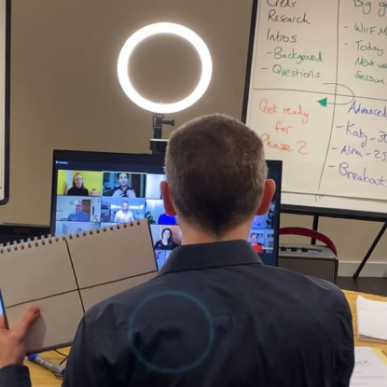“Upskilling” – it’s one of those buzzwords that seems to have been thrown around a lot more in recent years in businesses and workplaces. But what does upskilling mean for employees and for the Learning and Development (L&D) managers who support them?
In a world where AI, automation and new technologies are shaking things up daily, people don’t just want to learn new skills—they need to.
Whether it’s staying ahead of industry changes, future-proofing their careers or just keeping things interesting at work, employees are looking to L&D managers to provide the right opportunities. But here’s the big question: what kind of upskilling do employees really want in 2025?
What does upskilling actually mean?
People often talk about upskilling and reskilling as two sides of the same coin, but they’re actually different things.
Upskilling means learning new skills or improving existing ones to stay relevant in a changing work environment or improve performance in a current role. It helps employees adapt to new technologies, take on greater responsibilities and ultimately advance in their careers.
Reskilling, on the other hand, involves learning new skills to transition into a different job or industry, often due to changing job demands or career shifts. While reskilling focuses on acquiring completely new competencies for a different career path, upskilling is about deepening expertise in the current role by learning advanced techniques or new tools within the same field.
Why do employees want to upskill?
The term “FOBO,” or “fear of becoming obsolete,” has emerged as a significant concern among professionals. Rapid advancements in artificial intelligence (AI) and automation have heightened anxieties about job redundancy.
A recent Gallup poll revealed that a fifth of all workers in the US are worried that their job will be replaced by technology in the coming years. Employees are looking for businesses to provide urgent training so that AI complements human skills rather than replaces them.
It’s a vital part of building resilience and remaining agile. According to a recent LinkedIn report, the number of employees who say that learning helps them adapt during times of change has increased from 49% to 68% in the last three years alone. This increase shows that employee training is becoming much more important – and in demand.
What are the benefits of upskilling your employees?
The same LinkedIn report shows that employee retention is a huge challenge for businesses in 2025. The report states that a huge 88% of organisations say they are concerned about employee retention – but the good news is that providing quality learning opportunities to upskill staff is the number one retention strategy.
There are several benefits of upskilling your employees.
- Better Employee Engagement – When employees have opportunities to reskill and grow within the company, they feel more valued and motivated. This leads to higher job satisfaction, better retention and increased productivity.
- Future-Proofing the Workforce – Upskilling ensures that employees stay adaptable in the face of industry changes and technological advancements. By continuously developing skills, businesses can remain competitive while preparing their workforce for evolving roles.
- Avoiding Employee Burnout – Stagnation can lead to disengagement and burnout. Providing learning and growth opportunities keeps work fresh, challenging, and fulfilling, reducing the risk of employees feeling stuck or overwhelmed.
- Internal Mobility & Cost Savings – Upskilling existing employees to fill internal roles is an effective way to move talent within the organisation. This reduces the costs of external hiring while allowing employees to leverage their new skills to advance their careers.
What skills do employees most want to improve in 2025?
According to the World Economic Forum’s Future of Job’s Report 2025, technological skills are projected to grow in importance more rapidly than any other. This includes employees wanting to improve their skills in AI and big data, as well as areas such as cybersecurity and data literacy.
But away from tangible technological skills, there is a huge and growing demand for traditional ‘softer skills’ too, including leadership and influence, motivation, empathy and active listening, creative thinking, motivation and self-awareness. These are some of the top ten core skills that employees are looking for in 2025.
Attributes such as emotional intelligence, adaptability, communication, and storytelling skills are increasingly sought after too. These skills facilitate better teamwork, enhance problem-solving abilities and prepare employees for managerial roles.
What do employees want from training in 2025?
Enough time to do it
One of the primary obstacles to upskilling is time. Employees often have competing priorities and may deprioritise learning. Organisations can address this by designating specific times for upskilling. Some companies set aside one day a quarter for the workforce to dedicate to learning, while others encourage employees to spend an hour or more a week focused on developing new, valuable skills. Collecting employee feedback can help determine the most effective approach.
Training that helps career progression
Employees are motivated by clear pathways for career advancement. Upskilling initiatives that align with career progression strategies not only prepare individuals for future roles but also ensure organisational continuity. By identifying and nurturing internal talent, companies can fill leadership positions more effectively, reducing recruitment costs and retaining institutional knowledge.
Collaborative and social learning
The power of peer-to-peer learning cannot be underestimated. Employees often seek opportunities to learn collaboratively, sharing knowledge and experiences. Mentorship programs, workshops, and team-based projects build a culture of continuous learning and community. Such environments encourage innovation and collective problem-solving.
Belief that their training will be valued
For upskilling to be effective, it must align with the organisation’s strategic objectives. Employees want assurance that their new skills will be utilised and valued. L&D managers should work closely with leadership to identify skill gaps and future needs, ensuring that training programs are relevant and impactful. This alignment enhances employee engagement, as individuals see a direct correlation between their development and the company’s success.
Post-training support and continued learning
After training, it’s essential to have plans in place to apply new skills. Organisations should connect newly trained employees with opportunities to utilise their skills, such as assigning them to relevant projects or roles. This not only reinforces learning but also demonstrates the organization’s commitment to employee development. Additionally, continuous support through mentorship and resources ensures sustained growth.
Understanding what employees truly want from upskilling is essential for L&D managers looking to build a confident, future-ready workforce. While technical skills matter, it’s leadership and soft skills—like presentation skills and storytelling—that help employees stand out, inspire others, and drive real impact.
By creating opportunities for individuals to develop their communication, influence, and leadership abilities, companies cultivate an environment where employees feel empowered, engaged, and ready to take on bigger roles. This not only enhances individual career growth but also strengthens the organisation by fostering a culture of confident, compelling leaders.





















